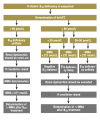Causes and early diagnosis of vitamin B12 deficiency
- PMID: 19623286
- PMCID: PMC2696961
- DOI: 10.3238/arztebl.2008.0680
Causes and early diagnosis of vitamin B12 deficiency
Abstract
Introduction: Vitamin B(12) deficiency is widespread. Among the population groups at risk are older people, vegetarians, pregnant women, and patients with renal or intestinal diseases. The neurological symptoms of vitamin B(12) deficiency are unspecific and can be irreversible. Early detection is therefore important, using the most sensitive and specific markers available.
Methods: Selective literature review.
Results and discussion: Total serum vitamin B(12) is a late, relatively insensitive and unspecific biomarker of deficiency. Holotranscobalamin (holoTC), also known as active B(12), is the earliest laboratory parameter for B(12) deficiency, while methyl malonic acid (MMA) is a functional B(12) marker that will increase when the B(12) stores are depleted. Isolated lowering of holoTC shows B(12) depletion (negative B(12) balance), while lowered holoTC plus elevated MMA and homocysteine indicates a metabolically manifest B(12) deficiency, although there still may be no clinical symptoms. The diagnostic use of holoTC allows treatment to be instituted before irreversible neurological damage occurs. As the first clinical manifestations of vitamin B(12) deficiency are unspecific, those at risk should have their B(12) status checked regularly, every two to three years. Because no randomized controlled trials have yet been completed, the diagnostic and therapeutic measures proposed here are merely recommendations.
Keywords: diagnosis; homocysteine; neurological diagnosis; treatment concept; vitamin B12.
Figures


References
-
- Sipponen P, Laxen F, Huotari K, Harkonen M. Prevalence of low vitamin B12 and high homocysteine in serum in an elderly male population: association with atrophic gastritis and Helicobacter pylori infection. Scand J Gastroenterol. 2003;38:1209–1216. - PubMed
-
- Clarke R, Grimley EJ, Schneede J, et al. Vitamin B12 and folate deficiency in later life. Age Ageing. 2004;33:34–41. - PubMed
-
- Graham SM, Arvela OM, Wise GA. Long-term neurologic consequences of nutritional vitamin B12 deficiency in infants. J Pediatr. 1992;121:710–714. - PubMed
-
- Herrmann W, Schorr H, Obeid R, Geisel J. Vitamin B12 status, particularly holotranscobalamin II and methylmalonic acid concentrations, and hyperhomocysteinemia in vegetarians. Am J Clin Nutr. 2003;78:131–136. - PubMed
-
- Lesho EP, Hyder A. Prevalence of subtle cobalamin deficiency. Arch Intern Med. 1999;159 - PubMed
LinkOut - more resources
Full Text Sources
Research Materials

